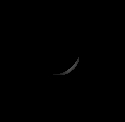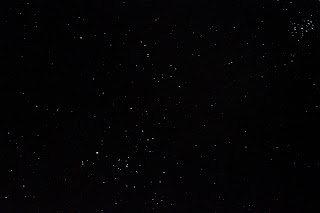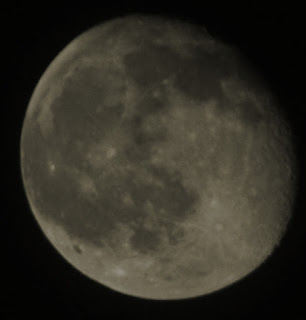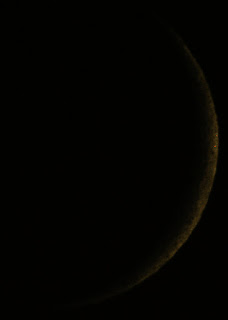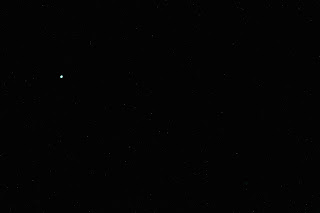December 29th Reprocesses
Continuing the previous set of reprocesses from April 3rd 2020, I stacked some shots of Venus with the Pleiades, although the shot was not clear.
I stacked 3 Hyades photos. The result was not bad but not as good as the Hyades photo I had taken earlier in the month.
December 28th Reprocesses
The predicted clear spell in the weather did not happen, so I revisited some earlier shots.
First up was the Moon in daylight on April 3rd.
Second was a solar image in hydrogen alpha light on the same day.
December 26th 1740 GMT M42 and M45
I decided to have a go at some deep sky shots but, this time, tried taking some dark frames. I used my normal settings of 300mm focal length, ISO 6400 and 2 seconds exposure.
The Orion Great Nebula (M42) was taken with 6 of 8 frames and 8 darks.
I got 19 frames to stack for M45 (Pleaides) but I have taken better shots with wider views.
December 26th 1645 GMT Venus
It cleared around sunset and I caught a very thin venusian crescent at 300mm focal length, ISO 100 and 1/100 second exposure.
December 25th 0125 GMT Moon
Christmas Eve had been very wet but there was a bit of clear sky before bedtime. I shot the Moon at 300mm focal length, ISO 100 and 1/250 second exposure.
December 23rd 2310 GMT Moon and Hyades
I snapped the Moon at 300mm focal length, ISO 100 and 1/250 second exposure.
With there being lots of moonlight around, I felt reluctant to do a lot of deep sky photography but I thought that the Hyades would show well. I set up my DSLR at 70mm focal length, ISO 6400 and 6 seconds exposure. The first shot was a complete fluke, as I caught the Pleaides in the same shot.
Using the same settings of 70mm focal length, ISO 6400 and 6 seconds exposure, I stacked 12 of 16 images with the Hyades in the centre of the image.
I also checked Betelguese and it had faded to about magnitude 0.55.
December
23rd 1640 GMT Dusk Shoot
I attempted to shoot Venus and Jupiter (separately) from a shopping centre in Bristol.
First was Venus at 300mm focal length, ISO 100 and 1/320 second exposure.
The Jupiter shots did not work.
December 22nd 0100 GMT Moon
At the end of the session I snapped the Moon at 300mm focal length, ISO 100 and 1/320 second exposure.
December 21st 2310 GMT Further Meteor Hunt
Conditions were slightly better. I used the same settings as before and repeated my 64 of 80 frame stack. This was better and also included the royal constellations of Cassiopeia and Cepheus.
I caught a bright UFO near the Pole Star at 2352 GMT.
At 0006 GMT, I caught a meteor, which was probably from the Ursid shower.
At 0052 GMT, I caught a short meteor trail in the same part of sky.
December 21st 2100 GMT Meteor Hunt
Conditions were quite poor, with cloud scattering moonlight but the Ursid meteor shower was in progress. I took multiple exposures at 18mm focal length, ISO 6400 and 6 seconds exposure.
I stacked 64 of the first 80 frames to obtain an image of Ursa Minor.
At 2122 GMT, I caught 2 UFOs near the Pole Star.
December 21st 1650 GMT Dusk Shoot
There was some clear sky around dusk with Venus and Jupiter visible, although I could not make Saturn out.
I started off with Venus with my DSLR at 300mm focal length, ISO 100 and 1/250 second exposure. I caught the phase just right.
I tried to catch Jupiter but should have used a longer exposure.
Venus and Jupiter were at their closest approach. I snapped them together at 18mm focal length, ISO 6400 and 1/40 second exposure.
December 18th Reprocesses
With the Moon staying hidden, I reprocessed a photo of Venus from February 3rd 2020.
I revisited a lunar shot from March 2nd 2020.
December 18th 1920 GMT Moon
Conditions were very poor and I needed to go to 1/10 second to capture the Moon. Unfortunately, there was some camera shake.
December 17th Reprocesses
I had finally caught up with processing the shoot from December 10th. Apart from a quick shoot on 12th, I had not had a whiff of clear sky. I reprocessed some frames from June 2nd 2020.
First was Jupiter's moons.
I revisited my Jupiter and Saturn shots but could not tease any meaningful image from them.
I then revisited a Moon shot from February 3rd 2020 and extracted more detail than the original, with the crater Clavius showing on the terminator.
December 12th 1615 GMT Moon
I caught the Moon during a rare clear patch but did not have time to get best focus.
December 10th 1905 GMT Meteor Hunt
This session started off on the right foot when my test frame at 18mm focal length, ISO 6400 and 6 seconds exposure threw up a nice set of winter constellations.
I also stacked 40 of 50 early frames to capture more stars.
At 1934 GMT, I saw a "guest star" near Rho Persei, which is, itself, close to Algol. It was inconclusive what it was.
At 1941 GMT, a similar event happened to the west (right) of Auriga.
At 1955 GMT, a third event happened which appeared as two star-like objects.
At 2000 GMT, another guest star appeared near the top left, which appeared as two short trails when I zoomed in. I also spotted a second event near Auriga.
It is somewhat with mixed feelings that I post the next shot. As a one-off it is interesting, even a bit pretty but when thousands of communication satellites cross the sky every night, it will ruin the night sky. I stacked 5 frames at 18mm focal length, ISO 6400 and 6 seconds exposure, taken 6 seconds apart.
I had a go at stacking some later frames of Auriga and Taurus. I changed the star detection threshold to 3% and stacked 48 of 61 frames.
I tried another set of frames later in the evening but they were out of focus. I saw some further evidence of UFOs.
December 10th 1815 GMT Moon and Jupiter
I had a go at photographing the Moon, Jupiter and Jupiter's moons but nothing worked.
However, with Procyon clear of the horizon, I "clocked" the magnitude of Betelguese at 0.4, as opposed to my estimate of 0.3 earlier in the evening.
December 10th 1715 GMT Moon and Venus
I snapped the Moon and Venus in the dusk sky at 300mm focal length, ISO 100 and 1/200 second exposure.
December 9th Reprocesses
I reprocessed a Moon shot from the evening of May 2nd 2020.
I caught Venus on the same evening.
December 7th 1640 GMT Dusk
Shoot
The Moon was East of Venus. I did not
attempt any planetary close-ups but, otherwise, the shoot was identical to the
one the evening before.
I started with the Moon at 300mm focal length, ISO 100 and 1/100 second exposure but the focus was slightly out.
I caught the Moon and Venus together at 70mm focal length, ISO 200 and 1/40 second exposure.
I tried to capture the Moon and Venus with Jupiter and Saturn but missed Saturn.
I took several photos at dusk from work. First up was the Moon and Venus at 70mm focal length, ISO400 and 1/6 second exposure.
Then there was the Moon at 300mm focal length, ISO 100 and 1/100 second exposure.
I used the same settings for Venus.






